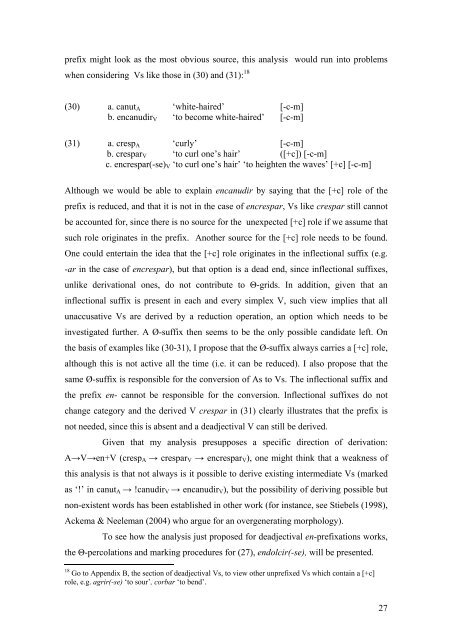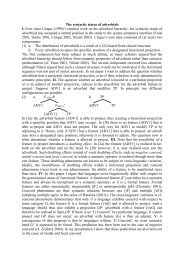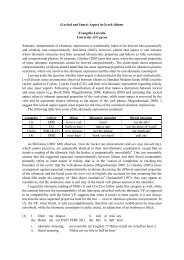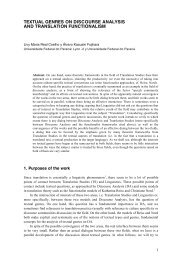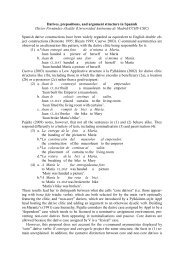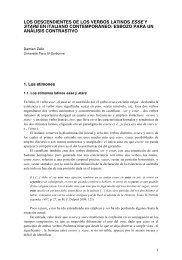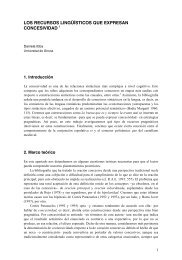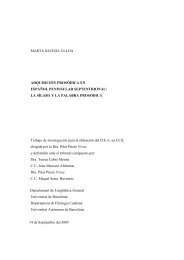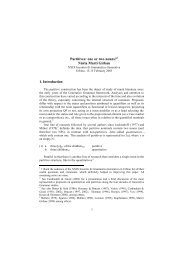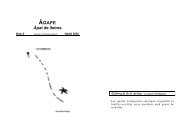Prefixation in English and Catalan - Departament de Filologia ...
Prefixation in English and Catalan - Departament de Filologia ...
Prefixation in English and Catalan - Departament de Filologia ...
You also want an ePaper? Increase the reach of your titles
YUMPU automatically turns print PDFs into web optimized ePapers that Google loves.
prefix might look as the most obvious source, this analysis would run <strong>in</strong>to problems<br />
when consi<strong>de</strong>r<strong>in</strong>g Vs like those <strong>in</strong> (30) <strong>and</strong> (31): 18<br />
(30) a. canutA ‘white-haired’ [-c-m]<br />
b. encanudirV ‘to become white-haired’ [-c-m]<br />
(31) a. crespA ‘curly’ [-c-m]<br />
b. cresparV ‘to curl one’s hair’ ([+c]) [-c-m]<br />
c. encrespar(-se)V ‘to curl one’s hair’ ‘to heighten the waves’ [+c] [-c-m]<br />
Although we would be able to expla<strong>in</strong> encanudir by say<strong>in</strong>g that the [+c] role of the<br />
prefix is reduced, <strong>and</strong> that it is not <strong>in</strong> the case of encrespar, Vs like crespar still cannot<br />
be accounted for, s<strong>in</strong>ce there is no source for the unexpected [+c] role if we assume that<br />
such role orig<strong>in</strong>ates <strong>in</strong> the prefix. Another source for the [+c] role needs to be found.<br />
One could enterta<strong>in</strong> the i<strong>de</strong>a that the [+c] role orig<strong>in</strong>ates <strong>in</strong> the <strong>in</strong>flectional suffix (e.g.<br />
-ar <strong>in</strong> the case of encrespar), but that option is a <strong>de</strong>ad end, s<strong>in</strong>ce <strong>in</strong>flectional suffixes,<br />
unlike <strong>de</strong>rivational ones, do not contribute to Θ-grids. In addition, given that an<br />
<strong>in</strong>flectional suffix is present <strong>in</strong> each <strong>and</strong> every simplex V, such view implies that all<br />
unaccusative Vs are <strong>de</strong>rived by a reduction operation, an option which needs to be<br />
<strong>in</strong>vestigated further. A Ø-suffix then seems to be the only possible c<strong>and</strong>idate left. On<br />
the basis of examples like (30-31), I propose that the Ø-suffix always carries a [+c] role,<br />
although this is not active all the time (i.e. it can be reduced). I also propose that the<br />
same Ø-suffix is responsible for the conversion of As to Vs. The <strong>in</strong>flectional suffix <strong>and</strong><br />
the prefix en- cannot be responsible for the conversion. Inflectional suffixes do not<br />
change category <strong>and</strong> the <strong>de</strong>rived V crespar <strong>in</strong> (31) clearly illustrates that the prefix is<br />
not nee<strong>de</strong>d, s<strong>in</strong>ce this is absent <strong>and</strong> a <strong>de</strong>adjectival V can still be <strong>de</strong>rived.<br />
Given that my analysis presupposes a specific direction of <strong>de</strong>rivation:<br />
A→V→en+V (crespA → cresparV → encresparV), one might th<strong>in</strong>k that a weakness of<br />
this analysis is that not always is it possible to <strong>de</strong>rive exist<strong>in</strong>g <strong>in</strong>termediate Vs (marked<br />
as ‘!’ <strong>in</strong> canutA → !canudirV → encanudirV), but the possibility of <strong>de</strong>riv<strong>in</strong>g possible but<br />
non-existent words has been established <strong>in</strong> other work (for <strong>in</strong>stance, see Stiebels (1998),<br />
Ackema & Neeleman (2004) who argue for an overgenerat<strong>in</strong>g morphology).<br />
To see how the analysis just proposed for <strong>de</strong>adjectival en-prefixations works,<br />
the Θ-percolations <strong>and</strong> mark<strong>in</strong>g procedures for (27), endolcir(-se), will be presented.<br />
18 Go to Appendix B, the section of <strong>de</strong>adjectival Vs, to view other unprefixed Vs which conta<strong>in</strong> a [+c]<br />
role, e.g. agrir(-se) ‘to sour’, corbar ‘to bend’.<br />
27


